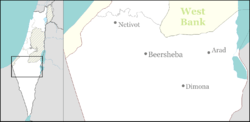Tel Sheva
Tel Sheva (Hebrew: תֵּל שֶׁבַע) or Tel as-Sabi (Arabic: تل السبع) is a Bedouin town in the Southern District of Israel, bordering the city of Beersheba. In 2019 it had a population of 20,808.[2]
Tel Sheva
| |
|---|---|
 | |
 Tel Sheva Location of Tel as-Sabi in Israel | |
| Coordinates: 31°14′48″N 34°51′22″E | |
| District | Southern |
| Founded | 1967 |
| Government | |
| • Type | Local council |
| • Head of Municipality | Musa Abu Isa[1] |
| Area | |
| • Total | 5,000 dunams (5 km2 or 2 sq mi) |
| Population (2019)[2] | |
| • Total | 20,808 |
| • Density | 4,200/km2 (11,000/sq mi) |
The first Bedouin township in Israel, Tel as-Sabi was founded in 1967[3] as part of a government project to settle Bedouins in permanent settlements and became a local council in 1984. It is one of seven Bedouin townships in the Negev desert with approved plans and developed infrastructure.[4]
History
The Negev Bedouin, a semi-nomadic society, has been going through a process of sedentarization since the later part of Ottoman rule in the region.
During the British Mandate period, the administration did not provide a legal frame to justify and preserve land ownership. In order to settle this issue, Israel's land policy was adapted to a large extent from the Ottoman land regulations of 1858 as the only preceding legal frame. Thus Israel nationalized most of the Negev lands using the state's land regulations from 1969.
Israel has continued the policy of sedentarization of the Negev Bedouins first imposed by the Ottoman authorities. Israel's measures at first it included regulation and relocation; during the 1950s Israel has relocated two-thirds of the Negev Bedouins into an area that was administered under martial law. The next step was to establish seven townships built especially for Bedouins in order to sedentarize and urbanize the Bedouins by offering them better life conditions, proper infrastructure and high-quality public services in sanitation, health, education, and municipal services. The other six townships are Hura, Lakiya, Ar'arat an-Naqab (Ar'ara BaNegev), Shaqib al-Salam (Segev Shalom), Kuseife (Kseife) and the city of Rahat, the largest among them.
Problems with the relocation program
Not all Bedouins agree to move from tents and structures built on state lands and into apartments prepared for them. Only about 60% of the Bedouin citizens of Israel live in permanent, planned villages like Tel as-Sabi, while the rest are living in illegal homes spread all over the northern Negev region.[5]
As Tel as-Sabi was the first Bedouin township in Israel, many mistakes were made by planners and government officials.[3] The authorities tried to learn from this while planning and building new Bedouin villages and towns. For example, creating an urban environment rather than a rural locality.[3]
As of 2000, the town has been ranked lowest (1 out of 10) in socio-economic standing, with an average income of 3,237 shekels (NIS), less than half the national average of 6,835 NIS. Only 43% of Tel as-Sabi's twelfth-grade students are eligible to graduate from high school.
Demography
According to the Israel Central Bureau of Statistics (CBS), the population of Tel as-Sabi was 13,000 in December 2005 and 15,700 in December 2010.[6] Tel as-Sabi's jurisdiction measures 5,000 dunams (5 km²).
Economy
Despite the fact that unemployment level among Negev Bedouins is high, there are several employment opportunities in the region. Several industrial parks are situated in the area - Ramat Hovav, Hura, but the closest industrial zone to Tel as-Sabi is situated in Beersheba. There are several organizations carrying out different activities aimed at supporting and expanding entrepreneurship in Israel's South in order to further integrate the 160,000 Bedouins living in the Negev into Israel's mainstream economy. They are primarily aimed at Bedouin women.
Twenty Arab-Bedouin women participated in a sewing course for fashion design at the Amal College in Beersheba, including lessons on sewing and cutting, personal empowerment and business initiatives.[7] A number of Bedouin women have undergone professional botanical training and established a business producing a range of unique skin care products based on traditional Bedouin herbal medicine.[8] Their products include cosmetic and dermatological lotions, creams and ointments.[9] Their products are manufactured at the laboratories of Hlavin, an international cosmetics manufacturer and exporter in Ra’anana.[10]
Education
There is a number of schools in the township and a communal activity center.
Sports
Hapoel Tel Sheva is a football team based in Tel as-Sabi, which is a member of the Israel Football Association.[11]
See also
- Arab localities in Israel
- Bedouin In Israel
References
- Prime Minister's Media Adviser (November 3, 2011). "PM Netanyahu meets with Negev Bedouin mayors" (Press release). Ministry of Foreign Affairs (Israel). Retrieved April 16, 2019.
- "Population in the Localities 2019" (XLS). Israel Central Bureau of Statistics. Retrieved 16 August 2020.
- Dr. Yosef Ben-David (1999-07-01). "The Bedouin in Israel". Israel Ministry of Foreign Affairs.
- State of Israel. Ministry of Justice, Ministry of Foreign Affairs. List of Issues to be taken up in Connection with the Consideration of Israel's Fourth and Fifth Periodic Reports of Israel (CEDAW/C/ISR/4 and CEDAW/C/ISR/5) Archived 2013-10-15 at the Wayback Machine
- Bedouin information, ILA, 2007
- "Statistical abstract of Israel 2011. POPULATION AND DENSITY PER SQ. KM. IN LOCALITIES NUMBERING 5,000 RESIDENTS AND MORE ON 31 XII 2010(1)" (PDF). Israel Central Bureau of Statistics. Archived from the original (PDF) on 2012-01-05. Retrieved 2010-12-31.
- Economic Empowerment. Arab-Bedouin Fashion Design Archived 2013-09-27 at the Wayback Machine
- Bedouin Projects. Asala Archived 2013-10-14 at the Wayback Machine
- Israel's Bedouin women turn desert plants into skin remedies
- Desert Beauty, Bedouin Style
- Team details. Hapoel Tel Sheva The Israel Football Association official site
External links
- Lands of the Negev, a short film presented by Israel Land Administration describing the challenges faced in providing land management and infrastructure to the Bedouins in Israel's southern Negev region